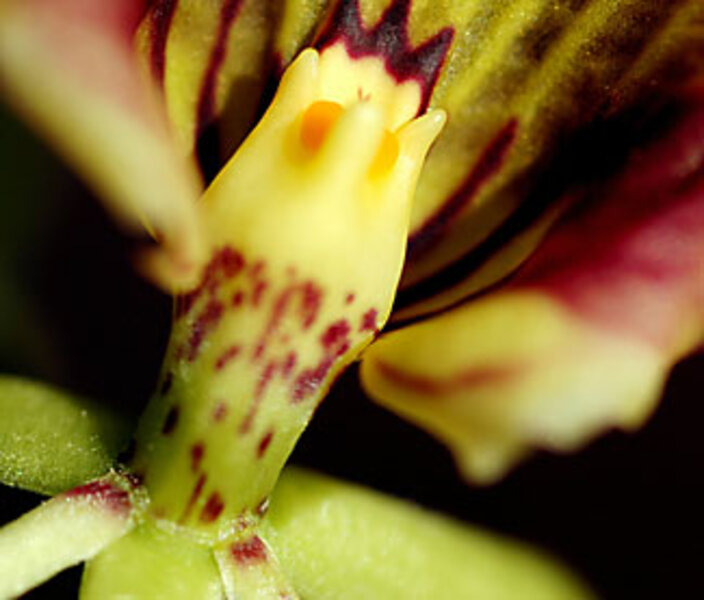Easy-to-grow beauties
Loading...
Sorry to say, Khanh Hamilton now takes care of only (only!) 3,500 orchids in her home. Before her old house burned down, she had 6,000 (really) – all of which grew and thrived without benefit of a greenhouse.
"It kind of took over my life," says Ms. Hamilton, who lives in Waukee, Iowa. "You ask my friends: I had orchids in the bathtub. The dining room table would be full of orchids.
With about half the number of orchids as she had before, "Now I can really enjoy it without working to death," Hamilton says.
She can oversee such a large operation because she sticks (mostly) to orchids that feel quite at home in your home.
"They're just like a [regular] houseplant," she says. "They're so easy."
"Easy" may not be the word you associate with growing orchids. But it's possible for anyone to brighten the household this winter with an orchid or two or three.
Here are some basic tips:
It's not true that the ubiquitous moth orchid – Phalaenopsis, usually called a "phal" (pronounced "fail") – gets its nickname because as an indoor flower it is fail-safe. But it is.
Anyone can grow a phal, and it seems these days that almost everyone has. Unlike the common perception of orchids as hothouse prima donnas, swooning willy-nilly like Victorian ladies aimed at a fainting couch, phals are sturdy beasts most comfortable in the temperatures we set for indoor living. And they bloom for approximately, oh, forever. My personal best: an unnamed white one continuously in bloom for 14 months. This was a birthday present that bloomed for two birthdays in a row.
They are also exceedingly long-lived. Years – decades even – and pumping out tennis-ball-size blossoms at least once a year like clockwork.
But you needn't limit yourself to an all-white palette. Phals also come in pink, purple, and yellow (my fave), as well as with various spots, stripes, and other novelties. As they used to say in far-too-loud TV commercials: Collect them all!
But even when seeking orchids with the greatest of ease, you needn't limit yourself to phals.
Oncidiums, which look for all the world like tiny ballerinas, are also deceptively simple. They like it a little warmer and drier than phals, but not so much that it matters all that much.
The variety called Gower Ramsey is just about bulletproof. Like all oncids, its quarter-size yellow and reddish-brown flowers are arrayed voluminously on 10-or-so-inch spikes, and it's nothing for a plant to have three or more spikes. So that would make (even in the new math) oodles of flowers on one plant. Maybe hundreds. And when you and Gower become comfortable with each other, it is possible to make it bloom three times a year. (Reluctant disclosure: my personal best – one in a row.)
My favorite easy orchid is one so brooding, so ethereal, so sinister (well, almost) that my wife and I refer to it as Vincent Price. (The rest of the world refers to it as Encyclia cochleata.) This purple-black and lime-green cockleshell flower has interior stripes and pendulous tentacles.
This plant is a tad bigger than the others, and a bit more robust. Length of flowering – what surfers and grape growers refer to as "hang time" – is impressive.
Encyclia radiata, a white variety, is wonderfully fragrant and nowhere near as spooky-looking. If E. cochleata is Vincent Price, E. radiata is Little Bo Peep.
While these three orchids grow in the wild by attaching themselves to trees, many orchids actually grow in the dirt. You might feel more comfortable starting off with orchids in a more familiar pot-and-soil situation than a orchid-pot-and-bark scenario. If so, here are three terrestrials that will accommodate you.
The jewel orchid, or Haemaria discolor, is a wonderful little thing, all velvety veined leaves and pea-size white and yellow flowers. This is one of the few orchids that actually look attractive while not in bloom, definitely a plus. When watering, I usually make a point to spill a bit of water on the leaves, where it separates into droplets that then are suspended on its Ultrasuede-like surface.
Lady slippers, or Paphiopedilums (nicknamed paphs), are another dirt denizen, characterized by a hooded flower with ribbonlike hangy-downy things. The compact Paphiopedilum sukhakulii is kind of green with burgundy spotting and a reddish tone to its lip. P. philippinense, which is darker, is remarkable for its spectacularly elongated, pendulous petals. Why not get them both?
So what was Hamilton's first orchid? The one that got her started on this road to madness?
"Phalaenopsis, of course," she immediately answers. "That's a beginner's specialty." Now she has ventured forth, especially into the world of Phragmapediums, which are similar to paphs.
"You can never know enough about orchids," Hamilton says. "The more you learn, the more you find that you don't know. But you can learn only as much as you like, and that can be enough."





